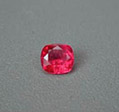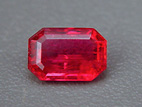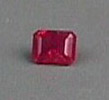


Found in white volcanic rhyolite; its color is contributed by cesium and manganese. Fewer than 10,000 stones are cut per year with more 95% of those being melee, mostly in lower grades. Various commercial mining ventures, in the past, have had sporadic success in producing stones, but a new enterprise, using more modern methods, is doing better. Red beryl remains, though, one of the most expensive of all colored gems. In recent years Russian synthetic red beryl has come on the market.



The great rarity of this material and its popularity with collectors means that almost any sized piece in any clarity and color grade can find a ready buyer. The best stones would have a raspberry pink to slightly purplish red color and be no more than slightly included. The rule of exponential increase with increase in size decidedly applies to this gem so often found in sub carat sizes. Cut is an afterthought, value-wise, in this material as cutters seek to produce the largest possible gem from their rough so windowed stones with poor proportions are in the majority.